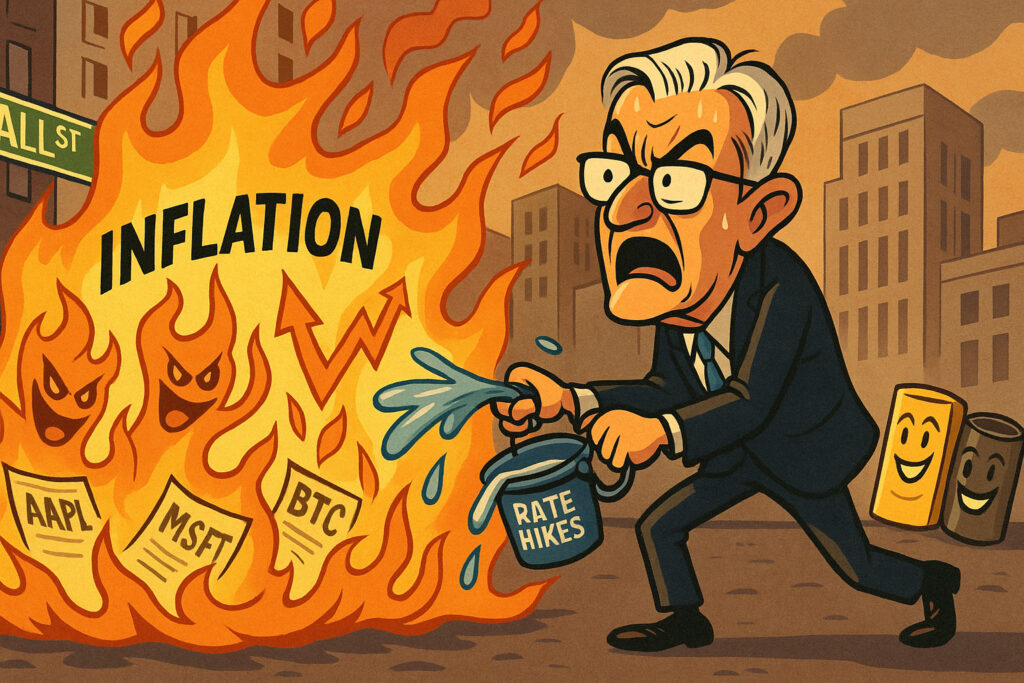Introduction
April 27, 2025 – Wall Street ended the session in the red as renewed inflation concerns rattled investors, reversing early gains and sending major indexes sharply lower. The Dow Jones Industrial Average shed over 400 points, while the S&P 500 and Nasdaq also suffered notable losses. Treasury yields spiked as bond markets priced in higher odds of further monetary tightening, and commodities including gold and oil saw significant moves. Markets are again grappling with the prospect that inflation may be stickier than anticipated, complicating the Federal Reserve’s policy trajectory.
Background
Throughout April, markets had clung to optimism that disinflation was on track despite persistent price pressures in housing, services, and energy. However, this fragile confidence was shaken today following the release of the Personal Consumption Expenditures (PCE) Price Index, the Fed’s preferred inflation gauge, which showed a hotter-than-expected 0.4% month-over-month increase for March and a stubborn 2.9% annual core rate.
This data comes at a precarious moment. After a slew of mixed earnings reports and signs of softening in housing and manufacturing, investors were betting on an imminent Fed pivot. Today’s inflation surprise forces a recalibration of rate cut expectations for 2025, intensifying uncertainty across asset classes.
Today’s Market Reaction
- Dow Jones Industrial Average: ↓ 412 points (-1.12%) to 36,480.21
- S&P 500: ↓ 53.67 points (-1.05%) to 5,037.88
- Nasdaq Composite: ↓ 187.43 points (-1.15%) to 16,044.32
- U.S. 10-Year Treasury Yield: ↑ 4.52%, highest since early March
- Gold Futures: ↑ 1.8% to $2,375.10/oz
- West Texas Intermediate (WTI) Oil: ↑ 1.2% to $89.30/bbl
- Bitcoin (BTC/USD): ↓ 2.5% to $58,740
Sector-wise, financials and energy outperformed modestly amid rising yields and oil prices, while technology, real estate, and consumer discretionary stocks bore the brunt of the selloff.
Notable movers included:
- Apple (AAPL): ↓ 2.2% to $174.80
- Microsoft (MSFT): ↓ 1.8% to $312.45
- ExxonMobil (XOM): ↑ 1.4% to $120.32
- Goldman Sachs (GS): ↑ 0.8% to $405.67
Analysis
The sharp market pullback today centers around inflationary dynamics and their implications for monetary policy. The hotter-than-expected core PCE figure not only underscores persistent service-sector inflation but also erodes the Fed’s confidence that it can achieve its 2% target without additional tightening.
Earlier in April, futures markets priced in two to three quarter-point cuts by the end of 2025. After today’s data, those expectations have diminished sharply. According to CME FedWatch Tool data, odds of a rate cut before September dropped below 35%, with some traders now even entertaining the possibility of a rate hike should inflation acceleration persist.
Treasury yields, especially on the 2-year and 10-year notes, surged, reflecting a rapid repricing of policy expectations. The yield curve steepened slightly, indicating both higher short-term rates and a softening growth outlook.
Equities, particularly growth and tech stocks, are sensitive to higher rates due to their valuation structure (future cash flows discounted more heavily). The Nasdaq’s outsized loss highlights this vulnerability.
Commodities showed mixed reactions: gold rallied as a hedge against inflation and financial volatility, while oil prices strengthened on lingering geopolitical tensions and supply-side constraints.
Bitcoin’s decline underscores the risk-off mood, as speculative assets came under pressure in favor of safe havens.
Short-Term Outlook
The coming days promise heightened volatility as traders digest the implications of today’s PCE print. Key focal points include:
- Federal Reserve Meeting (April 30 – May 1): Market participants will scrutinize Chair Powell’s tone for any shift in stance.
- Corporate Earnings Season: Major tech names including Amazon and Apple are set to report, providing insight into business resilience amid macro headwinds.
- Labor Market Data: Next week’s Nonfarm Payrolls report will be pivotal; continued labor strength would complicate the Fed’s inflation fight further.
- Geopolitical Developments: Any escalation in ongoing Middle East tensions could add an inflationary impulse via energy prices.
Options markets imply a spike in volatility into May, with the CBOE Volatility Index (VIX) jumping 14% today to 18.4. Traders are positioning for wide trading ranges as uncertainty around Fed policy and inflation persists.
Conclusion
April 27, 2025, marks a critical inflection point for financial markets. The resurgence of inflation fears has forced a painful reassessment of Fed policy outlooks, pressuring equities and boosting yields and safe havens. With the next FOMC meeting days away and earnings season in full swing, the stakes are extraordinarily high.
Investors must now navigate a landscape where both inflation risks and growth concerns weigh heavily. Near-term price action will be dictated by incoming macro data and Fed communications, but today’s sharp selloff sends a clear warning: the path to a soft landing is becoming increasingly treacherous.
